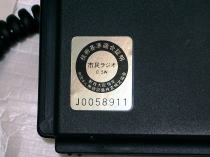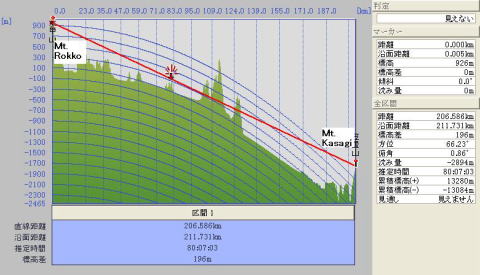Applicable Laws & Regulations:
Subsection 2, Article 4 of Radio Law,
Subsection 3, Article 6 of Regulations for Enforcement of the Radio Law,
and other related regulations or orders.
General restrictions and conditions under regulations:
[Qualification and License:]
Currently no qualification or license is required as far as you use the radio certified to the authorized Japanese technical standards specified by the government.
Radio Power: 500mW or less.
[Frequency/Channel:]
Frequencies are limited to those fixed 8 channels listed below:
- MHz/ Ch
- 26.968/ Ch1
- 26.976/ Ch2
- 27.040/ Ch3
- 27.080/ Ch4
- 27.088/ Ch5
- 27.112/ Ch6
- 27.120/ Ch7
- 27.144/ Ch8
[Rigs:]
Must be certified to authorized Japanese technical standards.
Cannot have any connection with external antenna. You can only use originally equipped antenna less than 200CM, most of which are usually rod antenna.
Microphone cord must be also less than 200CM. External MIC can be used, if the rig is originally equipped with external connection.
Other restrictions:
Any alteration is prohibited. You may not try to disassemble in any way
or may not even open the lids. The rigs must be so designed not to be easily
opened. Screws on the external body are covered with special seals.
(Photo: Certificate of Conformance to the technical standards
labeled on the rig.)
[Current availability:]
Since 1961 hundreds of models have been produced or ceased to be produced
by various manufacturers up to now. The producers included SONY, National
(=Panasonic), Toshiba, Hitachi, etc. Around March or April in 2005, SONY
put a period to producing ICB-87R, which was the last model one can obtain
as a brand-new rig. Currently no manufacturer in Japan produces the CB
radio certified to the Japanese technical standards as specified by the
government. The CB enthusiasts are now using mainly, 1) the rigs that they
used to use when they were younger (middle-high or high school student)
and kept in the closet, 2) the second-hand rigs that are obtained through
web auctions.
Legal rigs should not be mixed with CB radios produced in Japan specially
designed for export purpose and intended for use in the U.S. or other countries.
Operation of these machines as CB rigs in Japan is clearly against the
law.
Original manufacturers do not any more handle maintenance except for the recent models like SONY’s ICB-87R. Some models of old rigs can be overhauled and maintained at a special shop, “HST” in Kyoto.
Current operating situation:
[Local QSO]
Hundreds of CBers are actively operating CB radio now, who are frequently revivers from the early 1980s during which the CB radio was most popular in the history, especially among teenagers of those days. On Saturdays and Sundays, not a few active stations go for operation to the hillside or other higher places to make a local QSO.
[Es DXing]
Eastern part of Asia, including Japan, is well known for frequent emergence of Sporadic E Layer (Es) in the ionosphere in summer time. As well as local ground wave QSOs, from June to August, they are enjoying trying to make DX QSOs through Es, which are usually 500Km to 1300Km distance. Actually, during this period, almost every day, numbers of DX QSOs are made and reported in the web. Some stations are successful in 200 to 300 of such DX QSOs in one season. Most active players, from Hokkaido to Kyushu, very often use lunchtime for DX operation every day: some people are QRV, for example, from the roof of the office building and some from the dry riverbed near their offices. Also evening time after five are used by many stations for trying Es Dxing in this season.
[Roll Calls]
Roll calls are held on a regular basis (every month or every two weeks)
in those areas which have relatively more stations, such as 1, 2 and 3
Areas. In 1 Area, sometimes more than 50 stations are checking into the
roll call. (1, 2 and 3 are area codes used in amateur radio): West Tokyo
Roll Call (1 Area), Isewan Roll Call (2 Area), Kansai OAM (3 Area), etc.
[Diffracted Wave QSO]
Beyond-the-horizon or beyond-the-mountain QSOs, which distances are usually 100Km to 350Km or more are very often reported by the CB operators. For example, the 2 Area stations are usually enjoying the beyond-the-mountain QSO from Aichi, Gifu or Mie Prefectures with stations in 3 Area, such as those operating in Rokko Mountain, Hyogo Prefecture. There are 700m- to 1100m- high mountains between the 2 and 3 Areas and ground waves are not normally supposed to reach each other. Recent experimental QRVs by 2 Area CBers are revealing and adding more and more points in the map from which the beyond-the-mountain QSO are possible with Rokko Mountain or other points in 3 Area.
Aichi AE114, for example, reported a QSO at RS 52/41 between Kasagi Mountain
in Gifu Prefecture and Mt. Rokko in Hyogo Prefecture. (creepage distance
211Km)
The locations of the two stations and visibility are illustrated below.
(simulated by “Kashmir 3D”) The in-between mountain screen is deemed to
be a diffraction point. (A beautiful example like shown in a textbook.)

[Illegal operations ]
Most of them seem to be truckers, although sometimes “legal” stations are suspected to be using illegal output power. They are usually using export models of CB radios, which are not supposed to be used in Japan. Because they operate by strong output power with poor performance of band width, it is a big problem for ordinary CB stations that they very often get overlaps from close frequencies. In an effort to somehow reduce the QRM, most CBers use Ch8 or Ch3 for Dxing, which frequencies are relatively far from those used in high power export models operated by the illegal.
[Event Days]
Informal association of CBers set specific holidays for special operation days and recommended all CBers to operate simultaneously on those days. They are:
- New Year's Day (New Year Eve 21:00 through New Year's Day 15:00)
- Spring Equinox Day (around 23 March)
- Constitution Day (3 May 21:00 through 4 May 15:00)
- “Summer Vacation” (last Saturday (21:00) through Sunday (15:00) of July)
- Respect-for-the-aged Day (Monday of the third week of September)
- Culture Day (3 November)
The largest nationwide event is what is called “Summer Vacation”. The biggest number of CBers in a year will operate everywhere on this day from seaside to mountainside.
Other “License-free” radio:
There are two kinds of radio that can be categorized as “license-free”.
1) “Specified Small Output-Power Radio” (referred as “SS” radio):
- No qualification or license is required.
- Output power is 10mW or less.
- Frequencies:
Simplex 20 channels in 422MHz
Semi-duplex 27 channels in 421MHz & 440MHz
- Rigs must be only those certified to the authorized technical standards.
- No alteration allowed.
- Most CBers enjoy also operating the SS rig at the same time with CB radio. Many manufacturers are supplying the FM radio, which allows simplex, full-duplex and repeater functions, depending on the model. The radio is more often used for business use, such as for communications within a large factory, shop, parking lot, or at road works, rather than leisure use, such as skiing, hiking, etc., mainly because it may have repeater functions. CBers are using the rig as a QRPP machine by simplex or repeater mode. Because the radio power is only 10mW (or 1mW), ordinary people believe it can be useful only in a small area. In fact, in the city streets with closely spaced buildings or houses, you cannot communicate with a person in a hundred meters range. So naturally, they would never believe that we can communicate in QSO at a distance farther than 320Km, if we are in the range of “direct visibility”. My own record is 272Km by simplex mode (with Merit 5/ Merit 5) and 495Km by using one repeater (with M4/M5). Although I know the power of 10mW is QRO enough in the world of amateur radio QRPP, it should be noted we are just using originally equipped antenna (mostly 1/4 wave or less) and ground wave. Also one should note many of the SS radios have been designed with the same level of care for performance with making amateur radio by such manufacturers as Alinco, ICOM, Kenwood or Standard.
2) Personal Radio:
- Frequency: 158 channels in 903 to 904 MHz
- Mode: Narrow FM
- MCA (Multi Channel Access) System with ROM (Read only memory)
- Output power: 5W or less.
- Usage of external antenna is allowed up to gain of 7.14dBi, but it must be non-directional for horizontal plane. Usually, a vertical 1/2 wave or vertical stacks of 5/8 wave is utilized.
- No qualification required. License for station is required, but it is just
a matter of application.
In 1982, the government introduced the usage of radio in 903MHz to support better communications mainly aimed for automobile drivers and passengers. They were also used in the business scene, such as in communications between a base station and mobiles, where a private or small sized company managed employees using cars for services, deliveries etc. People were enjoying the radio, of course, as hobby use to make QSOs like CB radio. The usage of the radio got to the peak as the number of stations climbed up to more than 2 million in early 90s, but it sharply declined after people came to generally use cellular phones. I believe another reason for the decline was in the MCA system, which did not allow us to select any channel and did not eventually fit for hobby users who usually wanted to “manipulate” the radio.
The industry formed an association for the Personal Radio (PRPC) to recommend the usage of legal antenna so that stations would not abuse the use of directional antenna like Yagi, which was illegal. Those antennas recommended by PRPC had an orange color part somewhere on the antenna, to make it distinct from other antennas, including illegal ones. Because the orange color parts very often appeared on the top, the Personal Radio was commonly called as “Orange Top”.
5W of power, almost without any license, still attracts us, however, no manufacturer is currently supplying the radio. Apart from a lot of second hand rigs, you can frequently find brand new machines in the web auction sometimes from deadly stocked inventories.
© Nagoya YK221